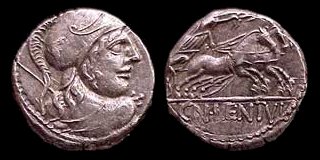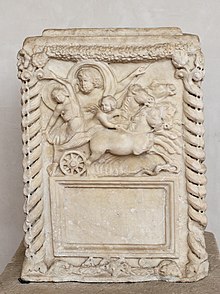
The Circus Maximus is an ancient Roman chariot-racing stadium and mass entertainment venue in Rome, Italy. In the valley between the Aventine and Palatine hills, it was the first and largest stadium in ancient Rome and its later Empire. It measured 621 m (2,037 ft) in length and 118 m (387 ft) in width and could accommodate over 150,000 spectators. In its fully developed form, it became the model for circuses throughout the Roman Empire. The site is now a public park.

Dis Pater, otherwise known as Rex Infernus or Pluto, is a Roman god of the underworld. Dis was originally associated with fertile agricultural land and mineral wealth, and since those minerals came from underground, he was later equated with the chthonic deities Pluto (Hades) and Orcus.

In Sabine and ancient Roman religion and myth, Luna is the divine embodiment of the Moon. She is often presented as the female complement of the Sun, Sol, conceived of as a god. Luna is also sometimes represented as an aspect of the Roman triple goddess, along with Diana and either Proserpina or Hecate. Luna is not always a distinct goddess, but sometimes rather an epithet that specializes a goddess, since both Diana and Juno are identified as moon goddesses.

In ancient Roman religion, the di nixi, also Nixae, were birth deities. They were depicted kneeling or squatting, a more common birthing position in antiquity than in the modern era. The 2nd-century grammarian Festus explains their name as the participle of the Latin verb nitor, niti, nixus, "to support oneself," also "strive, labor," in this sense "be in labor, give birth." Varro said that enixae was the term for women in labor brought about by the Nixae, who oversee the types of religious practices that pertain to those giving birth. In some editions of Ovid's Metamorphoses, a phrase is taken as referring to the birth goddess Lucina and her counterpart collective, the Nixi.

Chariot racing was one of the most popular ancient Greek, Roman, and Byzantine sports. In Greece, chariot racing played an essential role in aristocratic funeral games from a very early time. With the institution of formal races and permanent racetracks, chariot racing was adopted by many Greek states and their religious festivals. Horses and chariots were very costly. Their ownership was a preserve of the wealthiest aristocrats, whose reputations and status benefitted from offering such extravagant, exciting displays. Their successes could be further broadcast and celebrated through commissioned odes and other poetry.

Festivals in ancient Rome were a very important part in Roman religious life during both the Republican and Imperial eras, and one of the primary features of the Roman calendar. Feriae were either public (publicae) or private (privatae). State holidays were celebrated by the Roman people and received public funding. Games (ludi), such as the Ludi Apollinares, were not technically feriae, but the days on which they were celebrated were dies festi, holidays in the modern sense of days off work. Although feriae were paid for by the state, ludi were often funded by wealthy individuals. Feriae privatae were holidays celebrated in honor of private individuals or by families. This article deals only with public holidays, including rites celebrated by the state priests of Rome at temples, as well as celebrations by neighborhoods, families, and friends held simultaneously throughout Rome.

A quadriga is a car or chariot drawn by four horses abreast and favoured for chariot racing in Classical Antiquity and the Roman Empire. The word derives from the Latin quadrigae, a contraction of quadriiugae, from quadri-: four, and iugum: yoke. In Latin the word quadrigae is almost always used in the plural and usually refers to the team of four horses rather than the chariot they pull. In Greek, a four-horse chariot was known as τέθριππον téthrippon.

The Circus Flaminius was a large, circular area in ancient Rome, located in the southern end of the Campus Martius near the Tiber River. It contained a small race-track used for obscure games, and various other buildings and monuments. It was "built", or sectioned off, by Gaius Flaminius in 221 BC. After Augustus divided the city into 14 administrative regions, the Circus Flaminius gave its name to Regio IX, which encompassed the Circus and all of the Campus Martius west of the Via Lata.
The Secular Games was a Roman religious celebration (Ludi) involving sacrifices and theatrical performances held in ancient Rome for three days and nights to mark the end of a saeculum and the beginning of the next. A saeculum, supposedly the longest possible length of human life, was considered as either 100 or 110 years in length.

The Equirria were two ancient Roman festivals of chariot racing, or perhaps horseback racing, held in honor of the god Mars, one 27 February and the other 14 March.
In Greek mythology, the Taraxippus was a presence, variously identified as a ghost or dangerous site, blamed for frightening horses at hippodromes throughout Greece. Some taraxippoi were associated with the Greek hero cults or with Poseidon in his aspect as a god of horses who brought about the death of Hippolytus. Pausanias, the ancient source offering the greatest number of explanations, regards it as an epithet rather than a single entity.

Ludi were public games held for the benefit and entertainment of the Roman people . Ludi were held in conjunction with, or sometimes as the major feature of, Roman religious festivals, and were also presented as part of the cult of state.
The Ciconiae Nixae was a landmark, or more likely two separate landmarks, in the Campus Martius of ancient Rome. In A New Topographical Dictionary of Ancient Rome, Lawrence Richardson regards a single site called Ciconiae Nixae as "hypothetical", noting that the subject "has long exercised topographers." The two words are juxtaposed in the regionary lists and located in Region IX near the Tiber River. The 4th-century calendar of Filocalus notes vaguely that the October Horse happened ad nixas, "at the Nixae", suggesting that the regionaries' Ciconiae ("Storks") ought to be taken as a separate entry. Inscriptional evidence also indicates that the Ciconiae was a separate landmark, and that it had to do with wine shipments brought in on the Tiber.

In ancient Rome, the pompa circensis was the procession that preceded the official games (ludi) held in the circus as part of religious festivals and other occasions.

The biga is the two-horse chariot as used in ancient Rome for sport, transportation, and ceremonies. Other animals may replace horses in art and occasionally for actual ceremonies. The term biga is also used by modern scholars for the similar chariots of other Indo-European cultures, particularly the two-horse chariot of the ancient Greeks and Celts. The driver of a biga is a bigarius.

The Taurian Games were games (ludi) held in ancient Rome in honor of the di inferi, the gods of the underworld. They were not part of a regularly scheduled religious festival on the calendar, but were held as expiatory rites religionis causa, occasioned by religious concerns.

The di inferi or dii inferi were a shadowy collective of ancient Roman deities associated with death and the underworld. The epithet inferi is also given to the mysterious Manes, a collective of ancestral spirits. The most likely origin of the word Manes is from manus or manis, meaning "good" or "kindly," which was a euphemistic way to speak of the inferi so as to avert their potential to harm or cause fear.

In ancient Roman religion, the October Horse was an animal sacrifice to Mars carried out on October 15, coinciding with the end of the agricultural and military campaigning season. The rite took place during one of three horse-racing festivals held in honor of Mars, the others being the two Equirria on February 27 and March 14.
In the topography of ancient Rome, the Tarentum or Terentum was a religious precinct north of the Trigarium, a field for equestrian exercise, in the Campus Martius. The archaeological survey of the site shows that it had no buildings.

The Regio IX Circus Flaminius is the ninth regio of imperial Rome, under Augustus's administrative reform. Regio IX took its name from the racecourse located in the southern end of the Campus Martius, close to Tiber Island.















